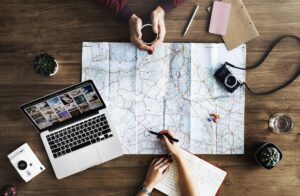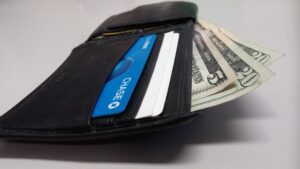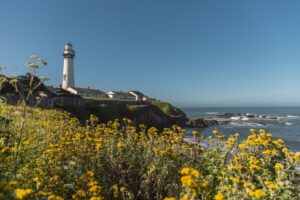Planning for a road trip can seem like a long and daunting task. Further, a poorly planned trip can be stressful and costly. After a recent 25-day road trip to the western United States, I put together a guide using some of the tips I use when planning a trip like this and some that I learned along the way. Here is a guide to how I plan and pull off a trip like this with a minimal amount of stress and within a reasonable budget. Give these ideas a try and you may find that planning will become an enjoyable part of the trip and you will be able to enjoy the trip without stress and worry.
Start with a list of “must see” and “must do” things
 Make a list of places and things that you really want to see and do on the trip that are most important to you. Use ideas from previous trips, videos, friends, and if you don’t know what’s out there (and even if you do), google things you’ve heard about, or even just towns and regions to get information. And, by all means, watch YouTube videos! I love creating this list in Google Sheets that I can access from my tablet or phone as well as my computer. The farther out you start this, the better the list will be!
Make a list of places and things that you really want to see and do on the trip that are most important to you. Use ideas from previous trips, videos, friends, and if you don’t know what’s out there (and even if you do), google things you’ve heard about, or even just towns and regions to get information. And, by all means, watch YouTube videos! I love creating this list in Google Sheets that I can access from my tablet or phone as well as my computer. The farther out you start this, the better the list will be!
On our trip out west, the big things were seeing the Red rocks of Sedona, riding the Grand Canyon Railway, the jet boat trip from Laughlin to London Bridge, The Cirque du Soleil “O” show in Las Vegas, eating at Hell’s Kitchen and Mon Ami Gabi, jeeping in the mountains around Ouray, and riding the Durango-Silverton Narrow Gauge Railroad.
Decide how much time each “must see” and “must do” thing will take
Think about this in terms of both days AND nights. If something will take all day, you are going to want to be there the night before and the night after. For example, riding the Grand Canyon Railway to the Grand Canyon, visiting the canyon, and returning to Williams took most of the day so I knew we needed to be in Williams the night before and the night after the trip. I added these numbers to two columns in my sheet.
Put the list in a logical travel order
 Think of a giant loop here. Use a physical map or go online. Simply connect the dots that represent the places from the start to the farthest point away and then return to complete a loop. Remember, since you have to get back, leave some of those points that don’t connect well for the return trip.
Think of a giant loop here. Use a physical map or go online. Simply connect the dots that represent the places from the start to the farthest point away and then return to complete a loop. Remember, since you have to get back, leave some of those points that don’t connect well for the return trip.
For our trip, the farthest point west from Texas was Las Vegas. Colorado was north so it made sense to do Arizona on the trip out and Colorado and northern New Mexico on the return trip. Our loop was not completed until we were almost back to San Antonio.
Add interesting and necessary stops along the way
 After you have worked out the order of the trip, you may discover that some segments are long while others are short. There are often interesting places along the way that can be added as a stopover to break up the trip or that will be a good way to spend time if it can be worked into the plan. Look for scenic or interesting routes to get between key points and add stops along the way if you’d like.
After you have worked out the order of the trip, you may discover that some segments are long while others are short. There are often interesting places along the way that can be added as a stopover to break up the trip or that will be a good way to spend time if it can be worked into the plan. Look for scenic or interesting routes to get between key points and add stops along the way if you’d like.
For example, on our western road trip, the first “must do” stop was Sedona, Arizona. Even though we were willing to drive for a long time on the first day, It was much too far to drive from San Antonio, our departure point. After watching YouTube and doing some research, I discovered Silver City, New Mexico. It seemed like an interesting place and was about right for our first day’s drive and a relatively easy drive for day two on to Sedona, even if we spent most of the morning in Silver City. It was added to the itinerary and it turned out to be a good choice that we enjoyed and might well add to a future itinerary.
Divide the trip into related segments
Divide the trip into segments or “chunks.” This will make it easier to work on and even creates a mental separation that makes it feel like several separate trips. Instead of that depressed feeling that the trip is over, there is the positive vibe of knowing that the next part is starting.
Our trip naturally divided into pieces that roughly fit states. The first section, that I called the Arizona segment, was 6 nights, and included Silver City which is actually in New Mexico; followed by Sedona, Arizona; Williams, Arizona and the Grand Canyon; and Laughlin which is actually in Nevada but just across the river from Arizona. Segment two was 7 nights in Las Vegas, segment 3 was 7 nights in Colorado, and segment 4 was New Mexico for the final 4 nights and included Red River and Ruidoso.
Work on each segment separately for itineraries and reservations
 Think of each segment as a separate trip when planning routes, creating itineraries, and making lodging and attraction reservations. You don’t have to reserve everything, but do your research and be sure you know the places and things that will need to be reserved in advance to avoid disappointments. This will especially be true if using sites like AirBnB or VRBO. I like to know where I’m going to be each night but don’t worry as much about what I’m doing during the day to get there unless buying tickets or making reservations is involved. All of this seems much less daunting if each segment is approached as a separate trip to be planned. You can work on them in any order and switch back and forth if you want a change of pace.
Think of each segment as a separate trip when planning routes, creating itineraries, and making lodging and attraction reservations. You don’t have to reserve everything, but do your research and be sure you know the places and things that will need to be reserved in advance to avoid disappointments. This will especially be true if using sites like AirBnB or VRBO. I like to know where I’m going to be each night but don’t worry as much about what I’m doing during the day to get there unless buying tickets or making reservations is involved. All of this seems much less daunting if each segment is approached as a separate trip to be planned. You can work on them in any order and switch back and forth if you want a change of pace.
On our trip, the level of planning was different for each segment. In the Arizona segment, it was important to reserve Sedona accommodations early along with the Grand Canyon hotel and train tickets. Laughlin and the jet boat could be done closer to departure and the last reservation I made was the hotel in Silver City. For other segments, I made Las Vegas reservations many months in advance because I got a deal and knew I could change or cancel and booked Cirque du Soleil shows as soon as tickets became available. I reserved a jeep in Ouray when they opened for the season, bought tickets to the Durango-Silverton Railroad several months in advance to get the car and seats I wanted, and then just started filling in the rest. The good news…almost everything can be done online!
Create a budget, starting with the big things in each segment
 Road trips with a lot of activities are not cheap! Start by planning the costs of the big items on your “must do” and “must see” list. Add in the costs of accommodations and meals (don’t forget about the expensive ones on your “must do” list), souvenirs, and of course fuel costs. I add in about 20% for things like park entry fees, snacks along the way, coffee stops, parking, Uber and Lyft, amusement rides, and those little things we forget about.
Road trips with a lot of activities are not cheap! Start by planning the costs of the big items on your “must do” and “must see” list. Add in the costs of accommodations and meals (don’t forget about the expensive ones on your “must do” list), souvenirs, and of course fuel costs. I add in about 20% for things like park entry fees, snacks along the way, coffee stops, parking, Uber and Lyft, amusement rides, and those little things we forget about.
For us the big item costs were for train tickets, Las Vegas shows, jet boat tickets, meals at a few expensive restaurants, jeep rental, and a gambling budget for hotels with casinos. We drove over 4,200 miles, so gas was certainly a major budget item. I like doing my budget in a Google sheet which allows me to have it with me at all times on my devices. I keep up with it throughout the trip.
Remove segments if they don’t fit within budgets or time constraints
This is a quick tip. If you don’t have the time or budget to do everything on your list, take out segments or parts of segments. See these things as parts or all of a future trip that you can begin planning when you get home!
I originally planned for our road trip to go all the way to the west coast but soon realized that there was just way too much to do for the time or budget that I had allotted and took out those parts of the trip. Hopefully, they will be a high priority on a future trip
Plan packing just like you would any other part of the trip
 We put so much time and effort into planning a trip and then wait until the last minute to pack! Further, we throw in everything that we think we might want and end up overpacking and lugging around a lot of extra stuff! Use the segments of your trip to plan for packing. A great way to do this is to pack in cubes in a larger suitcase that stays in the car.
We put so much time and effort into planning a trip and then wait until the last minute to pack! Further, we throw in everything that we think we might want and end up overpacking and lugging around a lot of extra stuff! Use the segments of your trip to plan for packing. A great way to do this is to pack in cubes in a larger suitcase that stays in the car.
Each of us packed clothes for each segment of our trip in cubes that would fit in carry-on size luggage. We put the cubes for the first segment of the trip in a carry-on and packed the rest in a larger suitcase that would stay in the car. To make this work, you must decide on what you actually need for each segment. In addition to the carry-on, each of us carried a backpack (the size that fits under an airplane seat) with our electronics, chargers, toiletries, paperwork, passports, and a change of clothing. At each stop we carried in the backpack and carry-on (and sometimes just the backpack). Dirty clothes were put in cubes and at the end of each segment, traded out for fresh cubes from the suitcases in the car. Valuables always went in with us and we had minimal things to carry. Each of us had a suitcase, a carry-on, and a backpack for a 25-day road trip! By the way, extra shoes stay in the car!
Take advantage of rewards points
 Hotel chains and restaurant chains have rewards programs. Take advantage of them and you may have not only discounted rates but free nights for a future trip. To use them, sign up online and book through their websites to accumulate and track points. You will see when you get free “stuff” and can take advantage of it on future bookings. I tend to stick with a few to maximize rewards through their loyalty programs.
Hotel chains and restaurant chains have rewards programs. Take advantage of them and you may have not only discounted rates but free nights for a future trip. To use them, sign up online and book through their websites to accumulate and track points. You will see when you get free “stuff” and can take advantage of it on future bookings. I tend to stick with a few to maximize rewards through their loyalty programs.
I used three different hotel rewards programs on our trip…Hilton Honors (this works at Hampton which I use a lot), Wyndham Rewards (works at a number of less expensive chains often available in smaller towns), and Best Western Rewards. Each of these has its own website for booking and tracking points. I used these to find hotels throughout trip planning. In addition, I use hotels.com which has its own loyalty program which will earn a free stay night after 10 nights booked. In addition to this, I always use players cards when in Las Vegas and a trip to Vegas the previous summer resulted in free hotel nights on this trip.
Use Credit Cards with points or cash back
 There are lots of credit card rewards cards out there. Some of these are branded while others are just general rewards cards that give rewards points for spending that can be used in a number of ways including cash back or credits applied to the bill. In general, find a couple you like and use them.
There are lots of credit card rewards cards out there. Some of these are branded while others are just general rewards cards that give rewards points for spending that can be used in a number of ways including cash back or credits applied to the bill. In general, find a couple you like and use them.
On our summer 2022 road trip, I used a Chase Freedom Visa Card and a Discover Card. Discover was offering 5X points on gasoline purchases during the time of our trip while Chase was offering a multiplier on restaurants in addition to points on all spending. By using these cards strategically during our trip I was able to earn several hundred dollars in cash back that I applied to the bill. Combined with hotel and dining rewards programs, using the right credit cards on road trips can lead to substantial savings.
Use removed segments and discoveries along the way to create “must do” & "must see" lists for future trips
 When I have to remove segments or parts of segments from a trip, it is made easier by the knowledge that this can be the start of another trip. In addition, when I see things while on a trip that I want to do but don’t have the time or budget for, I add them to a list of future things to do on a trip. This makes a great starting place for planning the next or a future trip.
When I have to remove segments or parts of segments from a trip, it is made easier by the knowledge that this can be the start of another trip. In addition, when I see things while on a trip that I want to do but don’t have the time or budget for, I add them to a list of future things to do on a trip. This makes a great starting place for planning the next or a future trip.
As stated earlier, our western road trip was originally intended to go all the way to the west coast but there just wasn’t time. It is already part of planning for a future trip. For me, planning is one of the fun parts of a road trip. I love making lists of possible things to do, places to stay, and of course places to eat!
Proper planning for a road trip can make the actual trip much less stressful in the knowledge that you know where you will be and when you will be there. This allows you to enjoy the travel, see the things along the way, be spontaneous within reason, and not spend your time worrying and stressing over what’s coming next. Use these tips and enjoy your next road trip!
Want to see our plan in action on our western road trip? Watch the entire trip video on our YouTube channel (@findushere) at https://youtu.be/csrMFmZvPgY
